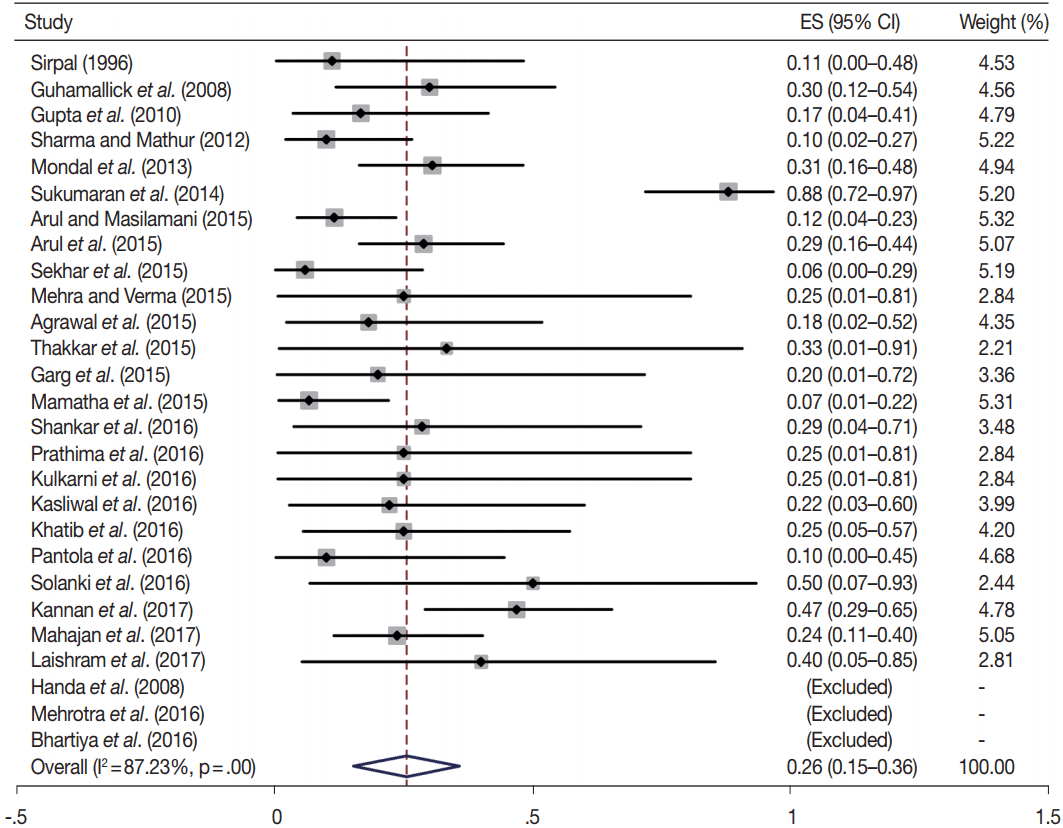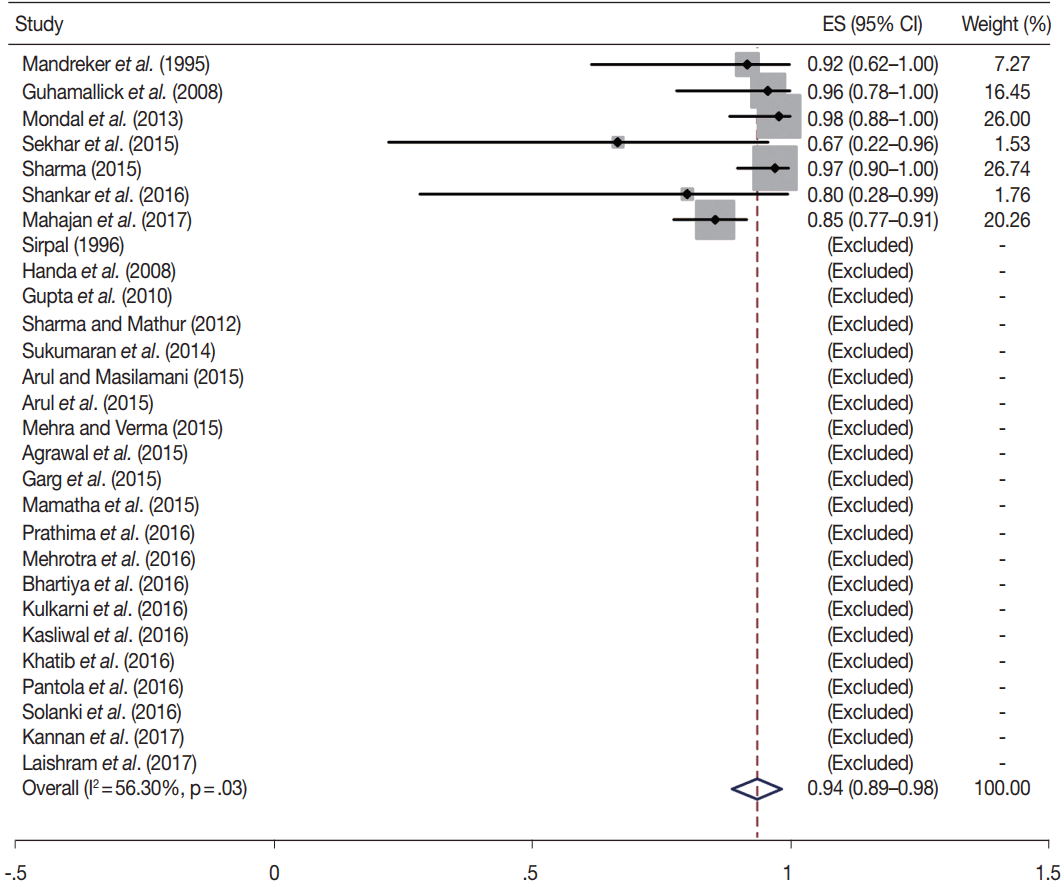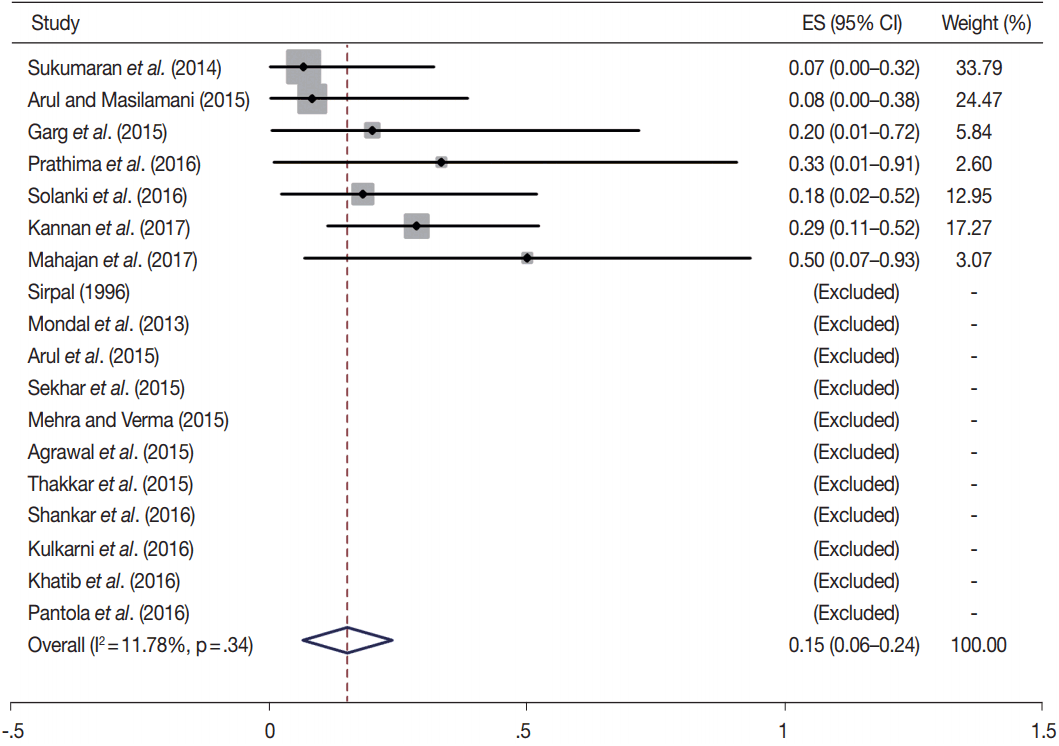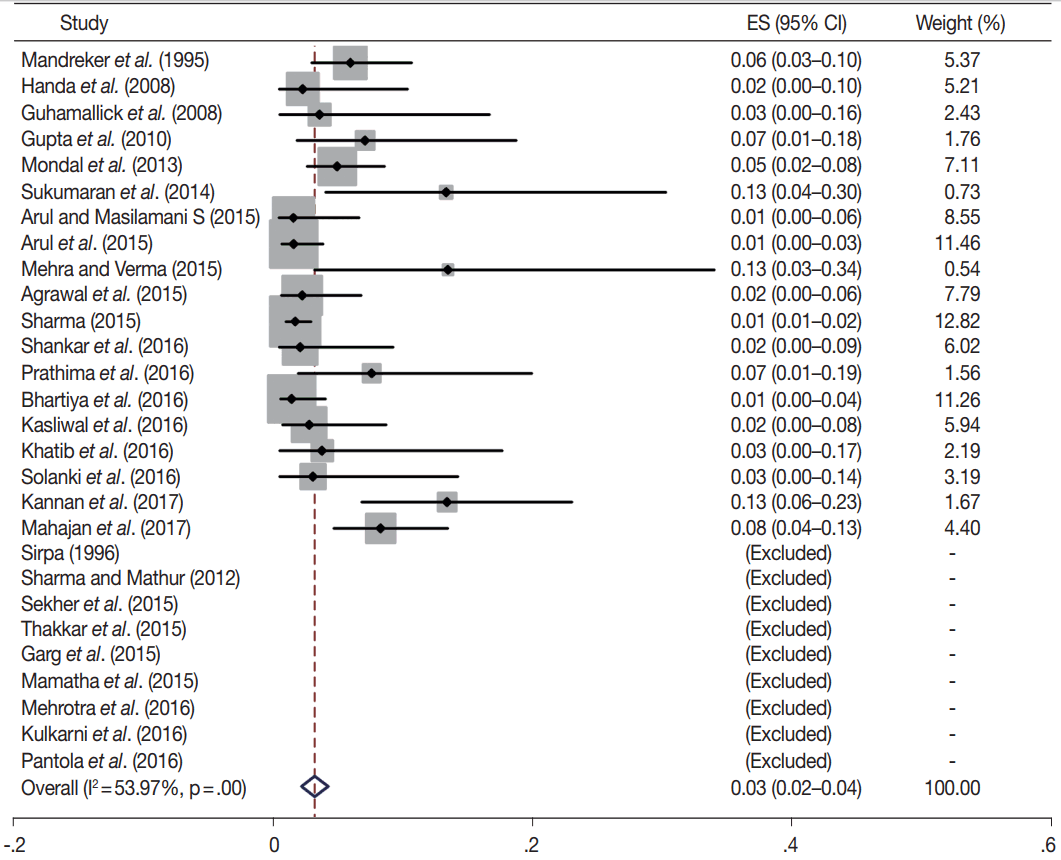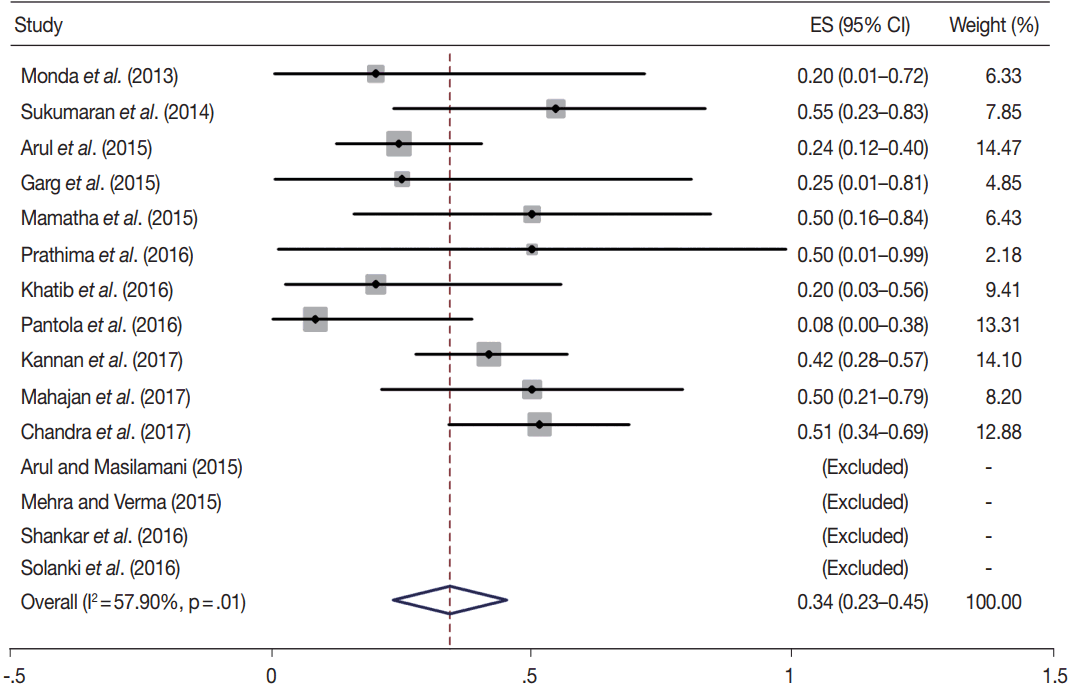Articles
- Page Path
- HOME > J Pathol Transl Med > Volume 51(6); 2017 > Article
-
Review
Thyroid Cytology in India: Contemporary Review and Meta-analysis - Shipra Agarwal, Deepali Jain
-
Journal of Pathology and Translational Medicine 2017;51(6):533-547.
DOI: https://doi.org/10.4132/jptm.2017.08.04
Published online: October 5, 2017
Department of Pathology, All India Institute of Medical Sciences, New Delhi, India
- Corresponding Author Deepali Jain, MD, DNB, FIAC Department of Pathology, All India Institute of Medical Sciences, New Delhi 110029, India Tel: +91-9868895112 Fax: +91-11-26588641 E-mail: deepalijain76@gmail.com
© 2017 The Korean Society of Pathologists/The Korean Society for Cytopathology
This is an Open Access article distributed under the terms of the Creative Commons Attribution Non-Commercial License (http://creativecommons.org/licenses/by-nc/4.0) which permits unrestricted non-commercial use, distribution, and reproduction in any medium, provided the original work is properly cited.
- Abstract
- BRIEF HISTORY OF THYROID FINE-NEEDLE ASPIRATION IN INDIA
- OPERATOR OF THYROID FINE-NEEDLE ASPIRATION
- CYTOTECHNICIAN TRAINING PROGRAM AND QUALITY CONTROL IN INDIA
- PREPARATION AND STAINING OF THYROID CYTOLOGY SAMPLES
- THYROID CYTOLOGY REPORTING SYSTEMS
- NON-DIAGNOSTIC CRITERIA FOR CYTOLOGICAL DIAGNOSIS
- ANCILLARY TECHNIQUES
- META-ANALYSIS OF THE RISK OF MALIGNANCY IN THE BETHESDA DIAGNOSTIC CATEGORIES
- CONCLUSION
- NOTES
- Acknowledgments
- REFERENCES
Figure & Data
References
Citations

- Spinal metastases in primary thyroid malignancies: Single center experience of 44 cases
Basir Ahmed, Edmond Jonathan, M. J. Paul, Krishna Prabhu
World Journal of Surgery.2025; 49(2): 409. CrossRef - Thermal imaging based pre-diagnostics tool for Graves’ disease
Vaishali Sharma, Vandana K Dhingra, Snehlata Shakya, Ashok Kumar, Mayank Goswami
Measurement Science and Technology.2024; 35(3): 035702. CrossRef - High Malignancy Risk and Its Predictors in South Indian Patients With Bethesda II Thyroid Nodules
Sunanda Tirupati, Pradeep Puthenveetil, Shilpa Lakkundi, Anudeep Gaddam, Vijaya Sarathi
Cureus.2024;[Epub] CrossRef - Nuclear features in thyroid cytology: features helpful for a morphological diagnosis in routine practice
Priya Bhagwat, Sabine Pomplun
Diagnostic Histopathology.2024; 30(6): 312. CrossRef - DIAGNOSTIC EFFICACY OF FNAC IN THYROID LESIONS, CLASSIFIED ACCORDING TO BETHESDA SYSTEM WITH CYTOHISTOLOGICAL CORRELATION
KIRAN KUMARI MEENA, SANDHYA BORDIA, POOJA KANWAT, SEEMA MEENA, PRAGYA JAKHAR
Asian Journal of Pharmaceutical and Clinical Research.2024; : 125. CrossRef - Evaluation of Thyroid Lesions by the Bethesda System for Reporting Thyroid Cytopathology
Syed Asif Hashmi, Monika Aggrawal, Rahul Pandey, Deepika Gulati, Inam Danish Khan
Journal of Marine Medical Society.2023; 25(1): 73. CrossRef - Incidence and Malignancy Rates in Thyroid Nodules in North-East Indian Population by Bethesda System: A Single Institutional Experience of 3 Years
Suvamoy Chakraborty, Manu C. Balakrishnan, Vandana Raphael, Prachurya Tamuli, Anuradha Deka
South Asian Journal of Cancer.2023; 12(02): 166. CrossRef - Evaluation of Concordance of Ultrasound, Cytology, and Histopathology in Solitary Thyroid Nodules
Sunil Chumber, Surabhi Vyas, Kamal Kataria, Shipra Agarwal, Yashwant S Rathore, Gopal Puri, Sushma Yadav, Kanika Sharma, Amit Patidar
Indian Journal of Endocrine Surgery and Research.2023; 18(1): 17. CrossRef - Cytomorphological Spectrum of Head and Neck Lesions by Fine Needle Aspiration Cytology in a Tertiary Care Center
Amandeep Kaur, Sonali Poonia, Karandeep Singh, Dalbir Kaur, Mohit Madhukar, Ravish Godara
Journal of Pharmacy and Bioallied Sciences.2023; 15(Suppl 1): S315. CrossRef - The Asian Thyroid Working Group, from 2017 to 2023
Kennichi Kakudo, Chan Kwon Jung, Zhiyan Liu, Mitsuyoshi Hirokawa, Andrey Bychkov, Huy Gia Vuong, Somboon Keelawat, Radhika Srinivasan, Jen-Fan Hang, Chiung-Ru Lai
Journal of Pathology and Translational Medicine.2023; 57(6): 289. CrossRef - Cytomorphological Categorization of Thyroid Lesions according to The Bethesda System for Reporting Thyroid Cytology and Correlation with their Histological Outcome
Meenakshi Kamboj, Anurag Mehta, Sunil Pasricha, Gurudutt Gupta, Anila Sharma, Garima Durga
Journal of Cytology.2022; 39(1): 44. CrossRef - Is Surgery Necessary in Benign Thyroid Lesions?
Pushkar Chaudhary, Naseem Noorunnisa
Journal of Datta Meghe Institute of Medical Sciences University.2022; 17(3): 799. CrossRef - Effect of the Noninvasive Follicular Thyroid Neoplasm With Papillary-Like Nuclear Features (NIFTP) Nomenclature Revision on Indian Thyroid Fine-Needle Aspiration Practice
Chanchal Rana, Pooja Ramakant, Divya Goel, Akanksha Singh, KulRanjan Singh, Suresh Babu, Anand Mishra
American Journal of Clinical Pathology.2021; 156(2): 320. CrossRef - The combination of ACR‐Thyroid Imaging Reporting and Data system and The Bethesda System for Reporting Thyroid Cytopathology in the evaluation of thyroid nodules—An institutional experience
Shanmugasundaram Sakthisankari, Sreenivasan Vidhyalakshmi, Sivanandam Shanthakumari, Balalakshmoji Devanand, Udayasankar Nagul
Cytopathology.2021; 32(4): 472. CrossRef - Differentiated Thyroid Cancer
Anita M. Borges
Journal of Head & Neck Physicians and Surgeons.2021; 9(2): 69. CrossRef - Risk of malignancy in Thyroid “Atypia of undetermined significance/Follicular lesion of undetermined significance” and its subcategories – A 5-year experience
Abha Thakur, Haimanti Sarin, Dilpreet Kaur, Deepak Sarin
Indian Journal of Pathology and Microbiology.2019; 62(4): 544. CrossRef - Thyroid FNA cytology in Asian practice—Active surveillance for indeterminate thyroid nodules reduces overtreatment of thyroid carcinomas
K. Kakudo, M. Higuchi, M. Hirokawa, S. Satoh, C. K. Jung, A. Bychkov
Cytopathology.2017; 28(6): 455. CrossRef - The Use of Fine-Needle Aspiration (FNA) Cytology in Patients with Thyroid Nodules in Asia: A Brief Overview of Studies from the Working Group of Asian Thyroid FNA Cytology
Chan Kwon Jung, SoonWon Hong, Andrey Bychkov, Kennichi Kakudo
Journal of Pathology and Translational Medicine.2017; 51(6): 571. CrossRef
 PubReader
PubReader ePub Link
ePub Link-
 Cite this Article
Cite this Article
- Cite this Article
-
- Close
- Download Citation
- Close
- Figure






Fig. 1.
Fig. 2.
Fig. 3.
Fig. 4.
Fig. 5.
Fig. 6.
| No. | Study | Place | Needle size and technique | Wet fixation | Staining technique used |
Reporting system followed | |
|---|---|---|---|---|---|---|---|
| Wet fixation | Air-dried smears | ||||||
| 1 | Mandreker et al. (1995) [13] | Goa | n/s | n/s | n/s | Unsatisfactory, benign, SFM, malignant | |
| 2 | Sirpal (1996) [14] | Delhi | 21G | n/s | Pap, H&E | Leishman-Giemsa | Malignant, non-neoplastic, FN, Hurthle cell tumors, thyroglossal cyst, extrathyroidal, inconclusive when unsatisfactory |
| 3 | Handa et al. (2008) [15] | Chandigarh | 23G ± aspiration, manual |
n/s | Pap, H&E | MGG | n/s |
| 4 | Guhamallick et al. (2008) [16] | Kolkata | 23–24G + aspiration | n/s | Pap, H&E | Leishman-Giemsa | Unsatisfactory, non-neoplastic, indeterminate, malignant |
| 5 | Gupta et al. (2010) [17] | Jammu and Kashmir | n/s | Ether-95% alcohol solution | Pap | n/s | Benign, FN, SFM, malignant |
| 6 | Bagga and Mahajan (2010) [18] | Haryana | 23–25G, non-aspiration |
95% Ethanol | H&E | MGG | Unsatisfactory, benign, SFM, malignant |
| 7 | Sengupta et al. (2011) [19] | Bihar | 22–23G + aspiration |
n/s | n/s | MGG | Colloid goiter, granulomatous thyroiditis, FA, FC, anaplastic carcinoma |
| 8 | Renuka et al. (2012) [20] | Andhra Pradesh | 22G ± aspiration, USG in some | 95% Methanol | Pap, H&E | MGG | TBSRTC |
| 9 | Sharma and Mathur (2012) [21] | Rajasthan | 23G + aspiration | Ether-95% alcohol solution | Pap, H&E | Giemsa | Unsatisfactory, non-neoplastic, FN, SFM, malignant (RCP) |
| 10 | Patel et al. (2013) [22] | Gujarat | 23–24G ± aspiration |
95% Ethanol | Pap, H&E | MGG | Non-neoplastic, neoplastic, others |
| 11 | Mondal et al. (2013) [23] | West Bengal | n/s, USG in some |
n/s | Pap | Leishman-Giemsa | TBSTRC |
| 12 | Kukar et al. (2013) [24] | Punjab | n/s |
95% isopropanol | Pap, H&E | MGG | Non-neoplastic, neoplastic |
| 13 | Bhasin et al. (2013) [25] | Punjab | n/s | n/s | n/s; MGG as per figures | TBSRTC | |
| 14 | Borgohain et al. (2014) [26] | Assam | n/s | n/s | n/s | MGG | Non-neoplastic, neoplastic |
| 15 | Mangshetty et al. (2014) [27] | Karnataka | 22–24G + aspiration | Alcohol | Pap | MGG | Unsatisfactory, benign, malignant |
| 16 | Panchal et al. (2014) [28] | Maharashtra | 22/23G + aspiration | 95% Ethanol | Pap | n/s | Unsatisfactory, benign, SFM, malignant |
| 17 | Pathak et al. (2014) [29] | Delhi | n/s | n/s | Pap | MGG | TBSRTC |
| 18 | Sukumaran et al. (2014) [30] | Kerala | n/s | 95% alcohol | Pap | n/s | TBSRTC |
| 19 | Arul and Masilamani (2015) [31] | Tamil Nadu | n/s | n/s | n/s, H&E as per figures | TBSRTC | |
| 20 | Arul et al. (2015) [32] | Tamil Nadu | n/s, USG if small lesion |
n/s | H&E | MGG | TBSRTC |
| 21 | Sekhar et al. (2015) [33] | Karnataka | 23–24G + aspiration | 95% Ethanol | Pap, H&E | MGG | TBSRTC |
| 22 | Mehra and Verma (2015) [34] | Delhi | n/s, USG in all | n/s | Pap | MGG | TBSRTC |
| 23 | Agrawal et al. (2015) [35] | Uttar Pradesh | 23G + aspiration | 95% Ethanol | Pap, H&E | MGG | TBSRTC |
| 24 | Sharma (2015) [36] | Tamil Nadu | n/s, manual | n/s | n/s | Unsatisfactory, benign, follicular pattern lesions, suspicious (includes atypical), malignant | |
| 25 | Thakkar et al. (2015) [37] | Gujarat | 22/24G + aspiration |
n/s | H&E | MGG | TBSRTC |
| 26 | Garg et al. (2015) [38] | Gujarat | 23–24G + aspiration |
n/s | n/s | TBSRTC | |
| 27 | Kathirvel (2015) [39] | Tamil Nadu | 25–27G | 100% Isopropanol | H&E | TBSRTC | |
| 28 | Alagarsamy et al. (2015) [40] | Tamil Nadu | 23G ± aspiration | 100% Isopropanol | H&E | n/s | Colloid goiter, adenoma, carcinoma, others |
| 29 | Mamatha et al. (2015) [42] | Telangana | n/s | n/s | n/s | n/s | Unsatisfactory, colloid cyst/goiter, follicular lesions/ neoplasm, indeterminate, SFM, malignant as well as TBSRTC |
| 30 | Gupta et al. (2015) [43] | Uttar Pradesh | n/s | n/s | Pap | Diff-Quick | Histopathological equivalents as well as TBSRTC |
| 31 | Hathila et al. (2016) [41] | Gujarat | 23G, non-aspiration | 95% Ethanol | Pap, H&E | MGG | Benign, malignant |
| 32 | Shankar et al. (2016) [44] | Tamil Nadu | n/s + aspiration | n/s | Pap | n/s | TBSRTC |
| 33 | Prathima et al. (2016) [45] | Karnataka | n/s, USG in some | Alcohol | Pap, H&E | Giemsa | TBSRTC |
| 34 | Mehrotra et al. (2016) [46] | Karnataka | n/s ± aspiration, USG in some | 95% Ethanol | H&E | MGG | TBSRTC |
| 35 | Tagore et al. (2016) [47] | Karnataka | 22G + aspiration | Alcohol | Pap | MGG | TBSRTC |
| 36 | Kalita and Das (2016) [48] | Assam | 23G ± aspiration | n/s | n/s | MGG | TBSRTC |
| 37 | Bhartiya et al. (2016) [49] | Bihar | 23–24G + aspiration, USG in some |
Wet fixed | Pap | Leishman-Giemsa | TBSRTC |
| 38 | Kulkarni et al. (2016) [50] | Madhya Pradesh | n/s | n/s | Pap | n/s | TBSRTC |
| 39 | Lohiya et al. (2016) [51] | Rajasthan | 23/24G | n/s | n/s | MGG | TBSRTC |
| 40 | Kasliwal et al. (2016) [52] | 24–26G + aspiration | 95% Ethanol | H&E | MGG | TBSRTC | |
| 41 | Khatib et al. (2016) [53] | Maharashtra | n/s, USG if unsatisfactory | n/s | Pap | Giemsa | TBSRTC |
| 42 | Pantola et al. (2016) [54] | Tamil Nadu | 23G | 95% Alcohol | Pap, H&E | MGG | TBSRTC |
| 43 | Babu et al. (2016) [55] | Tamil Nadu | 23G | Ether-95% alcohol solution | Pap | n/s | Unsatisfactory, benign, malignant |
| 44 | Solanki et al. (2016) [56] | Rajasthan | n/s | n/s | H&E | MGG | TBSRTC |
| 45 | Aramani and Gururajaprasad (2017) [57] | Karnataka | 24–25G + aspiration | 95% Ethanol | Pap, H&E | MGG | Benign, malignant |
| 46 | Sunder and Khan (2017) [58], |
Telangana | 23/25/26G + aspiration | 95% Ethyl alcohol or isopropanol | Pap, H&E | MGG | Benign, malignant |
| 47 | Garg et al. (2017) [59] | Maharashtra | n/s ± aspiration, USG in all | n/s | Pap | MGG | TBSRTC |
| 48 | Kannan et al. (2017) [60] | Karnataka | n/s |
n/s | n/s | n/s | TBSRTC |
| 49 | Mahajan et al. (2017) [61] | Chandigarh | n/s | n/s | n/s | n/s | TBSRTC |
| 50 | Chandra et al. (2017) [62] | Uttarakhand | 26–28G | Alcohol | Pap, H&E | MGG | TBSRTC |
| 51 | Laishram et al. (2017) [63] | Manipur | n/s | n/s | n/s | MGG | TBSRTC |
| No. | Study | Thyroid FNA (operated nodules) | Distribution of the Bethesda categories and corresponding risk of malignancy (%) |
|||||
|---|---|---|---|---|---|---|---|---|
| I | II | III | IV | V | VI | |||
| 1 | Mandreker et al. (1995) [13] | 1,992 (238) | 12.7 | 78.2 (5.5) | - | - | 7.6 (26.3) | 1.5 (91.7) |
| 2 | Sirpal (1996) [14] | 1,114 |
0.6 |
97.1 (0) | - | 1 (11.1) | - | 1.3 (100) |
| 3 | Handa et al. (2008) [15] | 434 (66) | 5.1 | 87.8 (1.9) | - | 3.2 (0) | - | 3.9 (100) |
| 4 | Guhamallick et al. (2008) [16] | 288 (75) | 13.5 | 68.4 (3.1) | - | 9.4 (30) | - | 8.7 (95.6) |
| 5 | Gupta et al. (2010) [17] | 75 (75) | - | 60 (6.7) | - | 24 (16.7) | 4 (0) | 12 (100) |
| 6 | Bagga and Mahajan (2010) [18] | 252 (32) | 1.6 | 90.5 | - | - | 6.7 | 1.2 |
| 7 | Renuka et al. (2012) [20] | 564 | 17 | 70.5 | 1.9 | 4.2 | 2.6 | 3.5 |
| 8 | Sharma and Mathur (2012) [21] | 94 (76) | 2.1 | 53.2 (0) | - | 35.1 (10) | 2.1 (100) | 7.4 (100) |
| 9 | Mondal et al. (2013) [23] | 1,020 (323) | 1.2 (0) | 87.5 (4.5) | 1 (20) | 4.2 (30.6) | 1.4 (75) | 4.7 (97.8) |
| 10 | Bhasin et al. (2013) [25] | 80 | 1.2 | 61.2 | 10 | 20 | 3.8 | 3.8 |
| 11 | Panchal et al. (2014) [28] | 300 (36) | - | 98.7 | - | - | 0.3 | 1 |
| 12 | Pathak et al. (2014) [29] | 454 | 25.7 | 59 | 6 | 4 | 1.8 | 3.5 |
| 13 | Sukumaran et al. (2014) [30] | 248 (248) | 6 (6.7) | 12.5 (12.9) | 4.4 (54.6) | 13.3 (87.9) | 4 (100) | 59.7 (100) |
| 14 | Arul and Masilamani (2015) [31] | 483 (209) | 5 (8.3) | 44.5 (1.1) | 2.9 (0) | 21.5 (11.5) | 15.3 (96.9) | 10.8 (100) |
| 15 | Arul et al. (2015) [32] | 603 (392) | 2.7 (0) | 65.2 (1.2) | 10 (24.4) | 10.6 (28.9) | 5.3 (70.8) | 6.3 (100) |
| 16 | Sekhar et al. (2015) [33] | 150 (64) | 2.6 (0) | 76.6 (0) | 0.7 | 12.7 (5.9) | 2.7 (100) | 4.7 (66.7) |
| 17 | Mehra and Verma (2015) [34] | 225 (40) | 7.2 (0) | 80 (13) | 4.9 (100) |
2.2 (25) | 3.5 (50) | 2.2 (100) |
| 18 | Agrawal et al. (2015) [35] | 281 (134) | 2.5 (0) | 87.9 (1.8) | 3.9 | 2.5 (18.2) | 1.8 (80) | 1.4 (100) |
| 19 | Sharma (2015) [36] | 724 (724) | - | 87.7 (1.3) | - | - | 2.9 (52.4) | 9.4 (97.1) |
| 20 | Thakkar et al. (2015) [37] | 134 (24) | 4.5 (0) | 85.8 (0) | 0.7 | 7.5 (33.3) | 0.7 | 0.7 |
| 21 | Garg et al. (2015) [38] | 100 (60) | 6 (20) | 78 (0) | 4 (25) | 5 (20) | 3 (66.7) | 4 (100) |
| 22 | Kathirvel (2015) [39] | 59 | 15.3 | 16.9 | 15.3 | 16.9 | 15.3 | 20.3 |
| 23 | Mamatha et al. (2015) [42] | 240 (214) | 10.8 | 59.2 (0) | 4.2 (50) | 15 (6.7) | 4.2 (60) | 6.6 (100) |
| 24 | Gupta et al. (2015) [43] | 300 | 11 | 78 | 2 | 3 | 1 | 5 |
| 25 | Shankar et al. (2016) [44] | 402 (92) | 10.7 (0) | 81.6 (1.6) | 1.2 (0) | 1.7 (28.6) | 2 (71.4) | 2.7 (80) |
| 26 | Prathima et al. (2016) [45] | 178 (60) | 11.7 (33.3) | 77.5 (7.1) | 1.1 (50) | 3.9 (25) | 2.2 (66.7) | 3.3 (100) |
| 27 | Mehrotra et al. (2016) [46] | 175 (34) | 4.6 | 68.6 (0) | 5.7 | 17.1 (0) | 1.1 |
2.9 |
| 28 | Tagore et al. (2016) [47] | 100 | 3 | 81 | 0 | 9 | 3 | 4 |
| 29 | Kalita and Das (2016) [48] | 664 | 12 | 72.3 | 1.8 | 4.8 | 1.5 | 7.5 |
| 30 | Bhartiya et al. (2016) [49] | 238 (105) | 5.9 | 84 (2) | 1.3 | 2.9 (0) | 2.5 | 3.4 (100) |
| 31 | Kulkarni et al. (2016) [50] | 151 (16) | 11.2 (0) | 76.8 (0) | 0 | 9.3 (25) | 0.7 | 2 (100) |
| 32 | Lohiya et al. (2016) [51] | 250 | 4 | 88 | 2 | 1.6 | 0.8 | 3.6 |
| 33 | Kasliwal et al. (2016) [52] | 411 (97) | 0.5 | 94.2 (2.6) | 0 | 3.5 (22.2) | 0 | 1.7 (100) |
| 34 | Khatib et al. (2016) [53] | 287 (287) | 0.7 (0) | 87.8 (3.3) | 3.5 (20) | 4.2 (25) | 1.7 (80) | 2.1 (100) |
| 35 | Pantola et al. (2016) [54] | 218 (44) | 5.5 (0) | 69.3 (0) | 10.5 (8.3) | 8.2 (10) | 2.3 (100) | 4.1 (100) |
| 36 | Solanki et al. (2016) [56] | 1,287 (62) | 22 (18.2) | 73.9 (2.6) | 0.7 (0) | 1.5 (50) | 0.4 (50) | 1.3 (100) |
| 37 | Kannan et al. (2017) [60] | 404 (243) | 7.7 (28.6) | 40.8 (13) | 24.3 (41.7) | 10.6 (46.9) | 6.9 (96.3) | 9.7 (100) |
| 38 | Mahajan et al. (2017) [61] | 4,532 (335) | 3.5 (50) | 79.6 (7.8) | 2.5 (50) | 3.9 (23.6) | 0.5 (75) | 9.8 (85.4) |
| 39 | Chandra et al. (2017) [62] | 971 |
5.5 | 74.9 | 6.4 (51.4) | 2.6 | 3.2 | 7 |
| 40 | Laishram et al. (2017) [63] | 576 (11) | 5.2 | 89.9 | 0 | 2.2 (40) | 0.3 | 2.2 (100) |
| Category | ROM |
RON |
|||||||
|---|---|---|---|---|---|---|---|---|---|
| Studies included for ROM | Pooled ROM (95% CI, %) | I2 (%) | p-value | ROM as per TBSRTC (%) [5] | Studies included for RON | Pooled RON (95% CI, %) | I2 (%) | p-value | |
| I | 18 | 15 (6–24) | 11.8 | .34 | 1–4 | 15 | 34 (17–52) | 65.5 | .01 |
| II | 28 | 3 (2–4) | 54 | .00 | 0–3 | 23 | 8 (6–10) | 80.3 | .00 |
| III | 15 | 34 (23–45) | 57.9 | .01 | 5–15 | 11 | 62 (44–81) | 77.4 | .00 |
| IV | 27 | 26 (15–36) | 87.2 | .00 | 15–30 | 23 | 81 (73–89) | 77.2 | .00 |
| V | 21 | 69 (55–84) | 87.7 | .00 | 60–75 | 17 | 76 (62–90) | 64.1 | .00 |
| VI | 28 | 94 (89–98) | 56.3 | .03 | 97–99 | 24 | 95 (90–99) | 58.1 | .05 |
FNA, fine needle aspiration; n/s, not specified; SFM, suspicious for malignancy; Pap, Papanicolaou stain; H&E, hematoxylin and eosin; FN, follicular neoplasm; MGG, May-Grünwald-Giemsa; FA, follicular adenoma; FC, follicular carcinoma; USG, ultrasound-guided aspirate; TBSRTC, The Bethesda System for Reporting Thyroid Cytopathology; RCP, Royal College of Pathologists guidelines. FNA performed by cytopathologist; FNA performed by clinician.
FNA, fine-needle aspiration. Excluding nine extrathyroidal; After adjustment of “inconclusive” to the Bethesda terminology; Only one case with available histology; Included 35 cases of category III with surgical follow-up.
ROM, risk of malignancy; CI, confidence interval; TBSRTC, the Bethesda System for Reporting Thyroid Cytopathology; RON, risk of neoplasia.

 E-submission
E-submission



